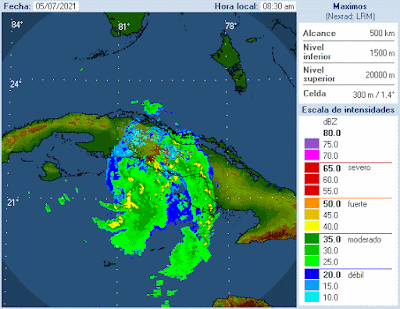Tropical Storm Elsa impacts Cuba and then tracks near the Florida Keys. It's a ragged, not well organized system proving a tag difficult to forecast what its impacts will be for South Florida.
As of Monday morning, the system was holding its own, even with its center being so close to land. But its structure is a bit lopsided. Since Sunday, Elsa is leaning to the East at the top and to the west at the bottom with most of the cloudiness sitting on the eastern half. It is a compact system with tropical storm force winds stretching out roughly 70 miles from the center. Clear skies are sitting to the north over Florida but some of that cloud deck should start reaching us today.
We will be watching for just how much impact Cuba has on Elsa and how strong/weak it is once it emerges into the Florida Straits.
Radar
Cuban radar loop detects the rain from Elsa impacting the Central Part of the Island. Here too, the rain sits on the eastern side of the storm. It has not been able to wrap around the center, an indication of Cuba's terrain having an impact on the storm.
Impacts
Elsa's impact on Cuba will be the following: Heavy rain with significant flooding specially on the eastern side of the storm. Gusty winds and a possible storm surge on the southern side of Cuba.
South Florida: Elsa is very much a lopsided storm. This means that even if the center passes well to the west of the Keys, most of its heavy rain will be on the eastern half. Here's a list from NWS on the Possible impacts. Keep in mind this may all change depending on how healthy Elsa is after its Cuba Crossing.
NWS guidelines for South Florida:
Prepare for dangerous wind having possible significant impacts across the Lower Keys. Potential impacts in this area include:
- Some damage to roofing and siding materials, along with damage to porches, awnings, carports, and sheds. Mobile homes damaged, especially if unanchored. Unsecured lightweight objects become dangerous projectiles.
- Several large trees snapped or uprooted, but with greater numbers in places where trees are shallow rooted. Several fences and roadway signs blown over.
- Some roads impassable from large debris, and more within urban or heavily wooded places.
- Scattered power and communications outages.
Also, protect against hazardous wind having possible limited impacts across the Middle and Upper Keys.
SURGE:
Prepare for locally hazardous surge having possible limited impacts across the Florida Keys. Potential impacts in this area include:
- Localized inundation with storm surge flooding mainly along immediate shorelines and in low-lying spots, or in areas farther inland near where higher surge waters move ashore.
- Sections of roads and parking lots inundated by surge water. Driving conditions dangerous in places where surge water covers the road.
- Moderate beach erosion.
- Minor damage to marinas, docks, boardwalks, and piers. A few small craft broken away from moorings.
FLOODING RAIN:
Prepare for locally hazardous rainfall flooding having possible limited impacts across the Florida Keys. Potential impacts include:
- Flood waters can enter some structures or weaken foundations. Several places may experience expanded areas of rapid inundation at underpasses, low-lying spots, and poor drainage areas. Some streets and parking lots take on moving water as storm drains and retention ponds overflow. Driving conditions become hazardous.
TORNADOES:
Prepare for a tornado event having possible limited impacts across the Florida Keys. Potential impacts include:
- The occurrence of isolated tornadoes can hinder the execution of emergency plans during tropical events.
- A few places may experience tornado damage, along with power and communications disruptions.
Mainland South Florida
* A few strong to locally severe thunderstorms will be possible across South Florida this afternoon into the evening hours, with the primary concern being isolated damaging wind gusts. Present indications are that this risk may be highest across the northern portions of South Florida. * Localized flash flooding from repeated rounds of heavy rainfall will be possible across South Florida, especially along the coastal/metro areas. Initially, this risk appears to be greatest across coastal/metro Collier County, with the risk increasing for the east coast metros during the overnight/morning hours. * A couple tornadoes will be possible across South Florida, with the greatest threat across the southern and western portions of the area this evening into Tuesday.
The bottom line is that we will see some of Elsa's impacts across South Florida. How severe will depend on a number of things:- How much shear will still be present over the Straits
- How weak it emerges from Cuba
- Will its land crossing affect its track. Just a tiny bit eastward and we'll see stronger impacts while a bit more west, even less.
We'll be watching.


















